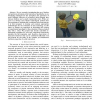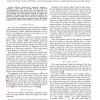ROMAN
2007
IEEE
14 years 9 months ago
2007
IEEE
Abstract— Human-robot collaboration requires both communicative and decision making skills of a robot. To enable flexible coordination and turn-taking between human users and a ...
ROMAN
2007
IEEE
14 years 9 months ago
2007
IEEE
— For a robot to be able to first understand and then achieve a human’s goals, it must be able to reason about a) the context of the current situation (with respect to which i...
ROMAN
2007
IEEE
14 years 9 months ago
2007
IEEE
Robot Programming by Demonstration (RbD) covers methods by which a robot learns new skills through human guidance. In this work, we take the perspective that the role of the tea...
ROMAN
2007
IEEE
14 years 9 months ago
2007
IEEE
— We are currently investigating the use of rhythm and synchrony in human-robot interaction. Specifically, we are developing techniques for the perception and generation of soci...
ROMAN
2007
IEEE
14 years 9 months ago
2007
IEEE
— For a robot to understand a scene, we have to infer and extract meaningful information from vision sensor data. Since scene understanding consists in recognizing several visual...
ROMAN
2007
IEEE
14 years 9 months ago
2007
IEEE
— Intuitive human-robot cooperation presents a challenge to robots since it demands of them a high level of understanding of the human user. Our approach is to estimate the human...
ROMAN
2007
IEEE
14 years 9 months ago
2007
IEEE
— We address in this paper the problem of the autonomous online learning of a sensory-motor task, demonstrated by an operator guiding the robot. For the last decade, we have deve...
ROMAN
2007
IEEE
14 years 9 months ago
2007
IEEE
–This paper presents a novel affect-sensitive human-robot interaction framework for rehabilitation of children with autism spectrum disorder (ASD) where the robot can detect the ...
ROMAN
2007
IEEE
14 years 9 months ago
2007
IEEE
— For controlling robots in an urban search and rescue (USAR) application, we present a wearable joystick with improved sensing capability as well as Giant MagnetoResistance(GMR)...
ROMAN
2007
IEEE
14 years 9 months ago
2007
IEEE
– The paper introduces an online user study on applications for social robots with 127 participants. The potential users proposed 570 application scenarios based on the appearanc...






